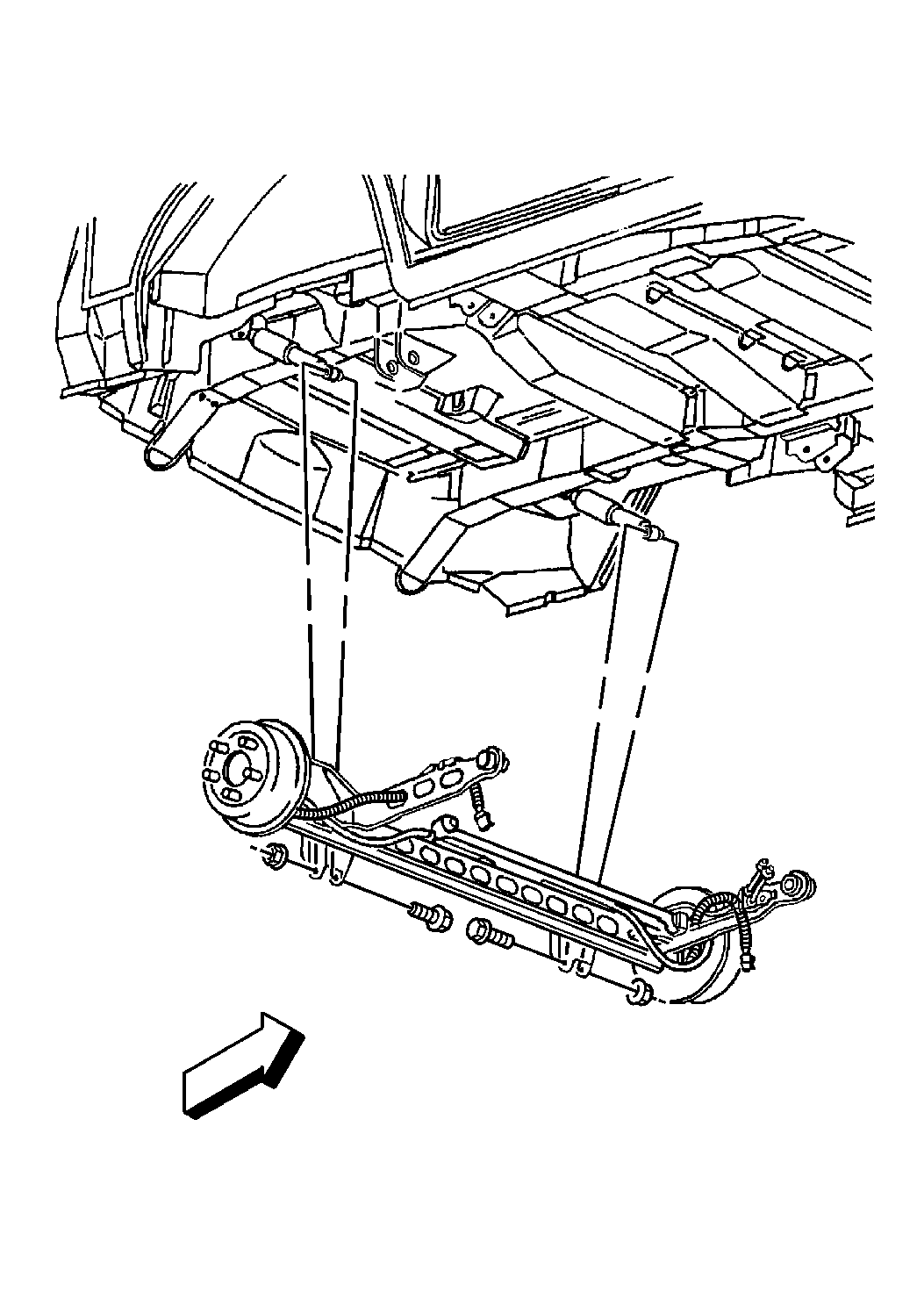Removal Procedure
Caution: When removing the rear springs, do not use a twin-post type hoist. The swing arch tendency of the rear axle assembly when certain fasteners are removed may cause it to slip from the hoist which may cause personal injury.
- Raise and support the vehicle. Refer to Lifting and Jacking the Vehicle in General Information.
- Remove the rear tires and wheels. Refer to Tire and Wheel Removal and Installation in Tires and Wheels.
- Use a utility stand in order to support the rear axle.
- Remove the rear axle coil springs, the spring seats and the spring insulators. Refer to Coil Spring Replacement .
- Remove the backing plate or the park brake support.
- Remove the park brake cables from the rear axle. Refer to Parking Brake Rear Cable Replacement - Left Side and Parking Brake Rear Cable Replacement - Right Side in Park Brake.
- Disconnect the intermediate brake hoses from the rear axle brake pipes. Refer to Rear Brake Hose Replacement in Hydraulic Brakes.
- Use the utility stand in order to lower the rear axle.
- Remove the utility stand.
- Lower the vehicle until the rear axle contacts the ground.
- Remove the rear axle control arm bolts and nuts.
- Remove the control arms from the vehicle.
- Remove the rear axle.
- Remove the brake pipes from the rear axle. Refer to Brake Pipe Replacement in Hydraulic Brakes.
Important: Place the vehicle lift pads where they will not obstruct the removal of the rear axle control arm bolts.
| • | For front-wheel drive vehicles, refer to Rear Brake Backing Plate Replacement in Drum Brakes. |
| • | For all-wheel drive vehicles, refer to Parking Brake Shoe Replacement in Park Brake. |

Installation Procedure
- Install the brake pipes to the rear axle. Refer to Brake Pipe Replacement in Hydraulic Brakes.
- Position the rear axle under the vehicle.
- Install the control arms to the vehicle.
- Install the control arm bolts.
- Install the control arm nuts.
- Raise and support the vehicle. Refer to Lifting and Jacking the Vehicle in General Information.
- Use the utility stand in order to raise the rear axle.
- Install the rear axle coil springs, the spring seats and the spring insulators. Refer to Coil Spring Replacement .
- Install the backing plate or the park brake support.
- Install the park brake cables to the rear axle. Refer to Parking Brake Rear Cable Replacement - Left Side and Parking Brake Rear Cable Replacement - Right Side in Park Brake.
- Install the intermediate brake hoses to the rear axle brake pipes. Refer to Rear Brake Hose Replacement in Hydraulic Brakes.
- Bleed the brake system. Refer to Hydraulic Brake System Bleeding in Hydraulic Brakes.
- Install the rear tires and wheels. Refer to Tire and Wheel Removal and Installation in Tires and Wheels.
- Lower the vehicle.

Notice: Use the correct fastener in the correct location. Replacement fasteners must be the correct part number for that application. Fasteners requiring replacement or fasteners requiring the use of thread locking compound or sealant are identified in the service procedure. Do not use paints, lubricants, or corrosion inhibitors on fasteners or fastener joint surfaces unless specified. These coatings affect fastener torque and joint clamping force and may damage the fastener. Use the correct tightening sequence and specifications when installing fasteners in order to avoid damage to parts and systems.
Important: This is a prevailing torque type fastener. This fastener may be reused ONLY
if:
• The fastener and its counterpart are clean and free from rust. • The fastener develops 4 N·m (37 lb in) of
torque (drag) against its counterpart prior to the fastener seating.
Tighten
Tighten the control arm nuts to 220 N·m (162 lb ft).
| • | For front wheel drive vehicles, refer to Rear Brake Backing Plate Replacement in Drum Brakes. |
| • | For all wheel drive vehicles, refer to Parking Brake Shoe Replacement in Park Brake. |
